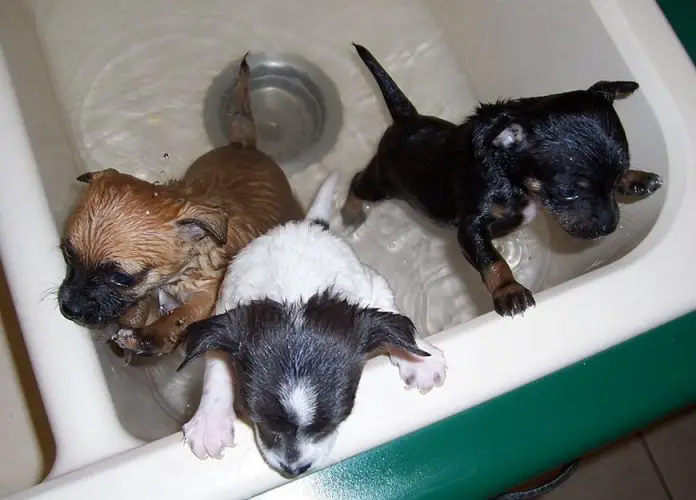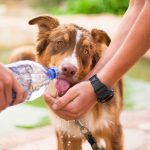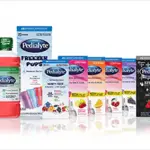Puppies enjoy a lot of playtime because it allows them to know more about the world they are living in. Because of their inclination in exploring the outdoors, they often end up dirty. This leaves pet owners wondering when it’s finally time to give the pup his bath and when they can repeat it.
When Should Puppies Have their First Bath?
Starting at 12 weeks, a puppy can already have his first full bath. At this stage, the puppy has completely weaned and already has the normal temperature of an adult dog.
Puppies aged 12 weeks and below are in the transitional stage and the temperature of their bodies is still adjusting. This is the reason why they always huddle with their mother and siblings. They preserve body heat by seeking shelter.
Newborn puppies should not have full baths because they are not yet capable of regulating their body temperatures. The mother dog has the maternal instinct to clean her babies and she does it by licking them.
Spot cleaning is recommended for week-old pups since they don’t get very dirty anyway. It is done by gently wiping spot areas using a warm washcloth. For instant cleaning or during travels, it would be more convenient to use dog cleaning wipes.
Aside from spot cleaning, you may also use a no-rinse foam dog shampoo to bathe your dog. Do note, however, that most waterless dog bath products are formulated for puppies aged 12 weeks or older.
Puppy Bath Time Must-Haves
It’s both frightening and exciting to bathe a puppy for the first time. To make the task easier for you, it’s important to prepare the essentials beforehand. Here are the things you will need to bathe your pup properly:
- Dog shampoo – a shampoo intended for adult dogs will be fine, as long as it is not a medicated shampoo intended to kill fleas and ticks. If your pup has sensitive skin, consider a puppy shampoo made of natural ingredients. There are puppy shampoos made for pets with sensitive skin and eyes. If your pet is white or has a light color, you can findshampoos made especiallyfor him. Don’t use human baby shampoo for your pup. Even if it is mild enough, it can leave his coat dull.
- Towel – you will need a large towel to dry off your pet. In case you haven’t bought one for your pet, consider buying a microfiber towel. They are super absorbent and they are easy to wash. There are pet towels with hand pockets that allow pet owners to grip the pet while drying him.
- Grooming Tub – you can simply bathe a dog in your sink, but if you want your pooch to have his own bathtub, you can purchase a utility sink intended for dogs. Some elevated tubs already come with a dog shower head spray. A raised bathtub can be very useful for large dog breeds.
How Often Should Puppies Take a Bath?
It has been said that a full bath is only necessary when the pup is already dirty, sticky, and smelly. But even if your puppy is always dirty, it’s not okay to bathe him every single day. A good wipe of his paws after his walks followed by brushing will be enough to keep him clean.
While you cannot bathe a pup every day, you can brush him regularly to keep his coat clean. Take note that the type of brush you should use will depend on the type of his coat. For pups with smooth coats, a rubber brush will be enough.
However, if your pup has a long and silky coat, you eventually need to invest in a pinhead brush. This kind of brush keeps mats and knots at bay.
Vets recommend bathing a dog only once a month. Still, you may want to check with your personal vet since not all dogs are the same. There are dog breeds that require less grooming than the others. Beagles, for instance, only need a full bath every two to three months.
Important Reminders for Pet Parents
For puppies with fleas, never use flea shampoos. They can be too harsh on a dog’s skin and most vets don’t recommend them regardless of the dog’s age. A sign of flea infestation is red skin that looks very itchy.
If you suspect that your pup is infected with fleas or lice, ask your vet for recommendations for topical flea and tick medication. Depending on the condition of your dog’s skin, your vet may also recommend antibiotics to treat any infection.
Don’t bathe an unvaccinated puppy aged 4 weeks or less. Short haired puppies, like Beagles, do not have much protection against cold weather. It’s also not recommended to bathe a pup on the day of this vaccination. It puts him at risk of developing a cold in case he was not dried thoroughly.
How to Bathe A Puppy the Right Way
Before bathing the pup, check the water temperature first. The recommended temperature is 37°C. Anything beyond that can increase your pup’s heart rate. In case you live in a colder region, keep your pet warm by turning on the central heating in your house.
Do note that it is only recommended to give him a warm dip if he was exposed to mud or wipe only the dirty spots. If you are ready, here’s how to do it.
- Brush a dog to get rid of tangles and mats.
- Put the puppy in the sink or in a laundry tub with his bathing essentials on the side.
- Wet the body and slather shampoo. Gently massage it all over his body. Start with the legs all the way to the face. For sensitive areas such as the ears and the face, you will need some cotton balls for cleaning.
- Rinse your pet well. Make sure there will be no soap residue as this can irritate his skin.
- Dry your puppy using a towel. You may use a blow dryer as long as the nozzle is not too near your dog’s fur and your pet is not scared by the noise.
- Brush the coat using a slicker brush that is appropriate for his size. Only brush when your pet is completely dry.
As always, only give a quick sponge bath. Bathing your pup for too long will irritate his sensitive skin. If your pup seems afraid to have his first bath, consider giving him a simple treat beforehand.
Conclusion
Bath time is not just a time for cleaning. You may also use this opportunity to further check your pup’s coat. Examine for skin conditions as you wash your pet. Make bath time comfortable for your pet so he will not hate it. Ensure the water is not too cold or too hot and use the right shampoo.






















